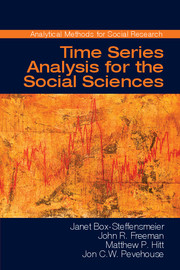Book contents
- Frontmatter
- Dedication
- Contents
- Preface
- 1 Modeling Social Dynamics
- 2 Univariate Time Series Models
- 3 Dynamic Regression Models
- 4 Modeling the Dynamics of Social Systems
- 5 Univariate, Nonstationary Processes: Tests and Modeling
- 6 Cointegration and Error Correction Models
- 7 Selections on Time Series Analysis
- 8 Concluding Thoughts for the Time Series Analyst
- Appendix Time Series Models as Difference Equations
- Bibliography
- Index
1 - Modeling Social Dynamics
Published online by Cambridge University Press: 05 December 2014
- Frontmatter
- Dedication
- Contents
- Preface
- 1 Modeling Social Dynamics
- 2 Univariate Time Series Models
- 3 Dynamic Regression Models
- 4 Modeling the Dynamics of Social Systems
- 5 Univariate, Nonstationary Processes: Tests and Modeling
- 6 Cointegration and Error Correction Models
- 7 Selections on Time Series Analysis
- 8 Concluding Thoughts for the Time Series Analyst
- Appendix Time Series Models as Difference Equations
- Bibliography
- Index
Summary
Many social processes are best understood in terms of changes over time. Current social conditions are outgrowths of people's memories of past conditions and, sometimes, also of people's expectations about future conditions. Social processes are rarely, if ever, at rest. Rather they are moving in time, trending in a regular way or exhibiting patterns that recur in time. Understanding the causal relationships between social variables across time and the forces that drive these variables through time is essential to explaining and forecasting social processes. We call these relationships and forces social dynamics. Time series methods are a powerful means by which to analyze these dynamics. In his essay on the history of time series, Tsay (2002, 121) emphasizes that studies of dynamic structures and dynamic relationships between variables have played a vital role in the development of the field, especially through applications in business and economics.
Many important social problems are conceived in terms of dynamics. Indeed, a broad array of questions across the social sciences cannot be addressed with-out utilizing data comprised of measurements of variables over time. The substantive bite of many empirical findings from the social world comes not from knowing the static level of an important variable at one frozen moment, but rather from understanding the dynamics of that variable. For instance: Is not is the phenomenon of interest rising? Falling? Repeating a pattern seasonally? Drifting randomly? Reverting to a stable value that we can forecast?
- Type
- Chapter
- Information
- Time Series Analysis for the Social Sciences , pp. 1 - 21Publisher: Cambridge University PressPrint publication year: 2014



